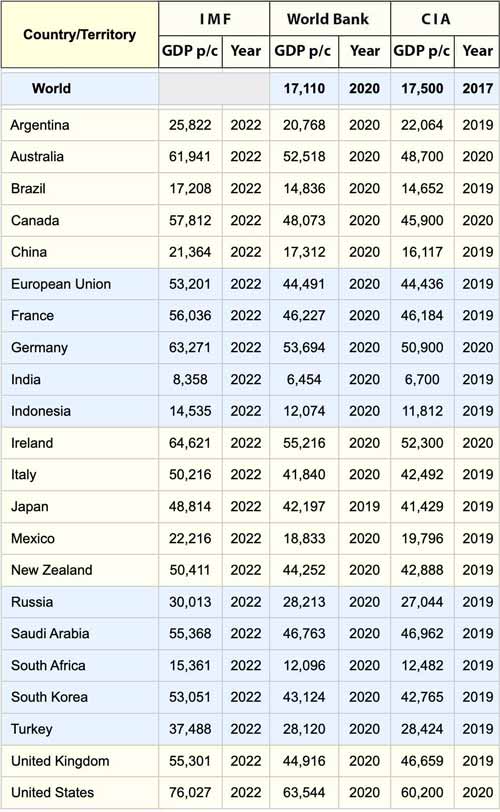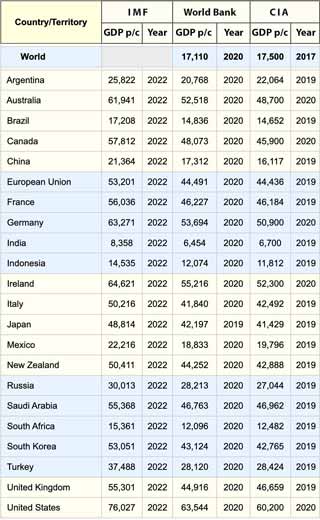How do Economists Measure National Production?
GDP is the primary indicator for measuring the country's business cycle phases, such as recession and expansion
Economists use several economic indicators to describe economic production for individual countries, including Gross Domestic Product(GDP) and Gross National Product(GNP). Another measure increasingly in the news is Gross National Income(GNI), essentially a version of Gross Domestic Product.
GDP, GNP, and GNI are in the spotlight whenever a national economy is in the news. This section starts with basic definitions of these terms, and sections below explain their meaning and use. The final section below presents current GDP figures from 184 countries.


Define Gross Domestic Product
Gross domestic product (GDP) is the total market value of all goods and services produced in the country, in a given year or quarter. GDP is equal to all government, consumer, and investment spending, plus the value of exports, minus the value of imports. GDP includes earnings made by foreigners while inside the country. GDP does not include earnings by its residents while outside of the country.
Define Gross National Product
Gross domestic product (GDP) is the total market value of all goods and services produced in the country, in a given year or quarter. GDP is equal to all government, consumer, and investment spending, plus the value of exports, minus the value of imports. GDP includes earnings made by foreigners while inside the country. GDP does not include earnings by its residents while outside of the country.
Define Gross National Income
Gross domestic product (GDP) is the total market value of all goods and services produced in the country, in a given year or quarter. GDP is equal to all government, consumer, and investment spending, plus the value of exports, minus the value of imports. GDP includes earnings made by foreigners while inside the country. GDP does not include earnings by its residents while outside of the country.
GDP is the Primary Indicator of Economic Output
Since the early 1990s, economists and government officials generally regard GDP (rather than GNP) as the primary indicator of a country's economic output.
GDP serves as the primary measure for identifying and measuring phases of the economy's business cycle, such as recession, depression, recovery, and expansion. Economic recession, for instance, is usually defined as two consecutive quarters of GDP decline. (For more on the cycle and these phases, see Business Cycle.
Sections below further explain the measurement and meaning of Gross Domestic Product, Gross National Income, and Gross National Product. Example tables present recent data on Country GDP and GDP per Capita for 100 country economies.
Contents
- How do economists measure national production?
- How do analysis compare GDP, GNI, and GNP figures?
- Determining GDP, GNI, and GNP.
- Understanding GDP figures based on PPP and exchange rates
- Table 1. Gross Domestic Product Estimates
for 100 Countries and Territories - Table 2. Gross Domestic Product per Capita
G20 Countries plus Ireland and New Zealand - Table 3. Gross Domestic Product per Capita
184 Countries and Territories Ranked by GDP per Capita
Similar Topics
- For more the well known economic phases recession, depression, recovery, and expansion, see Business Cycle.
Other Resources
Comprehensive GDP, GNI and GNP figures are available from quite a few different sources. Three of the more accessible sources are:
- The International Monetary Fund (IMF) World Economic Outlook
IMF data are update semiannually, in April and October. - The World Bank International Data Pages,
The World Bank updates data pages when individual sources make them available. - The CIA World Factbook
Reporting and Comparing GDP, GNI, and GNP
Analysts compare GDP, GNI and GNP figures in several ways. News reports typically focius on comparisons …
- Between quarters and years for a single country or groups of countries.
Purpose: to identify changes and trends in economic growth. - Between countriies.
Purpose: to show the size of a country's economy relative to other countries or groups of countries. - Between countries on a per capita basis,
Purpose: to show how the average wealth or poverty of individuals in a country comparea to people in other countries.
When comparing economic output measures across time, analysts normally adjust the figures adjusted to compensate for inflation. Adjusting for inflation gives a more accurate reading of changes in real purchasing power. In addition, when comparing economic output and purchasing power figures between countries, analysts express all figures in the same currency units.
As for the economic source data behind puiblished GDP, GNP, and GNI figures, Most data sources use one of the following approaches. They report …
- Without adjustments for inflation and purchasing power.
This is the nominal or official exchange rate (OER) basis. - With adjustments for inflation and purchasing power.
This is the PPP basis. PPP figures are expressed in International Dollars, which are adjusted to reflect average currency exchange rates and purchasing power parity (PPP).
Determining GDP, GNI, and GNP
Given the definitions of GDP, GNI and GNP above, economists take several different approaches to calculating values for these indicators To businesspeople generally, however, the most familiar approach is probably the so-called Expenditure Approach illustrated here.
- GDP = Consumption + Investment + Government spending + Exports - Imports
- GNI = GDP + payments by foreign nationals into the country for such things as investments (interest and dividends), less similar payments paid out of the country.
- GNP = GDP + Net Income Receipts from assets abroad less income of foreign nationals within the country.
Understanding GDP Exchange Rate and PPP Figures
Example GDP figures for 100 countries appear in table below. Data are CIA World Fact Book1 estimates for the most recent year available, 2016 (except for Syria and North Korea, for which the estimates represent 2015).
The tables present two figures for each country. The CIA World Fact Book1 describes these two approaches as follows:
GDP Figures Based on Purchasing Power Parity (PPP)
These entries gives the gross domestic product (GDP) or value of all final goods and services produced within a nation in a given year. A nation's GDP at purchasing power parity (PPP) exchange rates is the sum value of all goods and services produced in the country valued at prices prevailing in the United States in the year noted.
This is the measure most economists prefer when looking at per-capita welfare and when comparing living conditions or use of resources across countries.
GDP Figures Based on Official Exchange Rates.
This entries refer to the gross domestic product (GDP) or value of all final goods and services produced within a nation in a given year. A nation's GDP at official exchange rates (OER) is the home-currency-denominated annual GDP figure divided by the bilateral average US exchange rate with that country in that year.
This measure is simple to compute and gives a precise measure of the value of output. Many economists prefer this measure when gauging the economic power of an economy maintains vis-à-vis its neighbors, judging that an exchange rate captures the purchasing power a nation enjoys in the international marketplace.
GDP and GDP per Capita Figures in Tables 1, 2, and 3
in the next section
use PPP-base calculations.
GDP and GDP per Capita Current Estimates
Eonomists use GDP figures from many sources, but the most frequently used and most accessible are the estimates from the International Monetary Fund (IMF)1, World Bank2, and the United States CIA3. Tables 1, 2, and 3 Below are country-specific GDP and GDP per capita figures from these sources.
These tables present the most current data available as of July 2022. All figures are in current international dollars, with rounding to the nearest whole number. The GDP and GDP per capita figures on this page derive from Purchasing Power Parity (PPP) calculations from the IMF and the World Bank. Basing these estimates on PPP takes into account each country's relative cost of living and inflation rate.
- Table 1. Gross Domestic Product Estimates
for 100 Countries and Territories - Table 2. Gross Domestic Product per Capita
G20 Countries plus Ireland and New Zealand - Table 3. Gross Domestic Product per Capita
184 Countries and Territories Ranked by GDP per Capita
Table 1. Gross Domestic Product for 100 Countries and Territories
Ranked in Order of IMF GDP
Current International Dollars and PPP-Base Calculations


Table 2. Gross Domestic Product per Capita
G20 Countries, Ireland and New Zealand
Current International Dollars and PPP-Base Calculations


Table 3. Gross Domestic Product per Capita
184 Countries and Territories Ranked by GDP per Capita
Current International Dollars and PPP-Base Calculations


Footnotes
- The International Monetary Fund (IMF) World Economic Outlook
IMF data are update semiannually, in April and October. - The World Bank International Data Pages,
The World Bank updates data pages when individual sources make them available. - The CIA World Factbook

